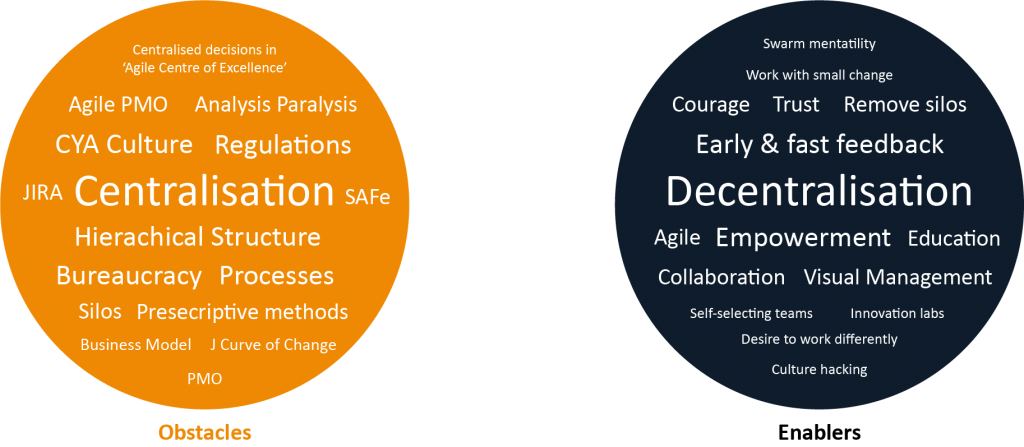We are living in a new economic and societal model characterised by fast-changing consumer demand and perpetual connectivity. In this model, businesses have to create highly individualised customer experiences and promote instant solutions for users’ problems in order to remain competitive.
Because of this, more organisations are becoming aware of the necessity of adaptable processes, structures, behaviours and mindsets — that allows people to recognise and respond to opportunity. This essential need for agility is much more relevant than any other discussion regarding methods or frameworks.
Most organisations need to adapt their business models to promote business-wide agility. This is a vital element for survival in the ‘Now’ economy. But how are established companies suppose to confidently abandon old thoughts and create new behaviours in a world of uncertainty? In this blog, we will explore a few ideas behind ‘organisational plasticity’.
Ephemeral truths
Traditional models of management worked on the assumption that even in a complicated system, it was possible to predict certain behaviour when things changed. However, due to the fast pace of innovation and intense competition of today, companies are being exposed to the effects of VUCA1 (Volatility, Uncertainty, Complexity, and Ambiguity).
VUCA can be summarised into an elementary idea. This idea is about the fact that ephemeral truths exist within all organisations, which means some of our certainties— about both aspects of micro and macro environments— only last for a short time.
Knowing this implies that we should be very cautious with the policies and processes we define within organisations. The burning questions, then are:
- How do we ensure policies and processes remain effective in solving new problems?
- How long do the certainties behind policies and processes last?
Most of the certainties of the past are no longer valid. And most likely, the certainties we are defining today will not be true tomorrow, so we have to develop the ability to continuously question our own beliefs. That is the best way to survive in the VUCA world.
That is the reason why we should have short cycles to review the effectiveness of definitions regarding processes, rules, roles, and structures. And also why organisations should be flexible enough to evolve their design in order to respond to business challenges. This ability is an essential ingredient for business agility.
Flexible and adaptable like a living organism
What’s the best metaphor to describe an organisation? Well, it’s possible to have many metaphors. However, my favourite one is that of the organisation as a brain. Due to the high level of variability and dynamism, it’s fair to say that the organisation is not a machine or a set of immovable things.
It’s a living, breathing organism shaped by both the people who work in it and by its customers. For this reason, I believe the brain is the best metaphor to capture the complexity and adaptability of some organisations. So how about using a few examples of the brain’s abilities as insights to help us improve our companies?
Neuroplasticity: the great inspiration
If we look at some of the aspects of the brain, we will notice characteristics like neuroplasticity. In the book Neuroplasticity2 (the MIT Press Essential Knowledge series), Moheb Costandi3 states:
“Neuroplasticity simply means change in the nervous system, and is a collective term for all the processes that change the structure and function of the brain. Brains evolved to respond and adapt to the environment, and so neuroplasticity is an intrinsic property of nervous tissue, which occurs at all levels of organization, from the genetic to the behavioural.”
As a broader concept, plasticity is about the quality of being easily shaped or moulded. This is the same quality we need in corporate systems. In order to survive and grow, modern companies should be able to change their structure and function. It should become an intrinsic property to respond and adapt to the environment. We can name this property ‘organisational plasticity’.
What exactly is organisational plasticity?
It’s possible to summarise the concept of organisational plasticity as: the ability to quickly rewire the organisational tissue to continually improve collective thoughts and behaviours.
Which means, a plastic organisation can evolve its structures and processes without much effort and trauma when it is needed. It’s about flexibility, adaptability, resilience and easy responsiveness to deal with unpredictable events.
It’s important to note that organisational plasticity is not a methodology, a framework, or even a mindset. Organisational plasticity is not something to be ‘implemented’ in your organisation. In fact, your organisation has this ability already.
Organisational plasticity is a natural characteristic similar to neuroplasticity in human brains. This ability has been present in all companies since their organisational genesis. However, this ability may be locked due to the excess of processes, policies, rules, structures, etc. Our mission is to minimise the blockers and maximise the enablers to achieve organisational plasticity.
Enablers and blockers
I’ve been studying different companies over the last few years to identify the most common enablers and blockers of organisational plasticity. I found many examples of elements that have been stopping or helping these organisations. See the tag clouds below for the common (and intriguing) obstacles and enablers for the better levels of plasticity.

It’s about change to business as usual
For many years, change management was an important element in organisations. Most of the time, change is an unavoidable thing. You change, or you die (period!). That was the reason why the ability to plan and control change was essential for many companies. Indeed, it was an important skill. However, the rate of change has increased over the last decades. Recently, our ability to predict and control change has become less effective.
Consequently, the discipline of change management has had to change, as well. Nowadays, change is ongoing stuff. Organisations are always changing and evolving. There is no room for long transformation projects with well-defined final stages. Our vision about what the future version of the organisation will be is also an ephemeral truth. We need to continuously inspect and adapt our certainties (especially the ones involving our vision regarding the future).
Organisational plasticity is exactly this ability. Enabling companies to evolve their shapes and functions easily, is the greatest benefit of having good levels of organisational plasticity. And this is the reason why unlocking this ability is so vital for modern organisations.
Further reading:
Manoel’s research slide pack from Agile2018 in San Diego.
References:
- How VUCA Is Reshaping The Business Environment, And What It Means For Innovation
- Neuroplasticity
- Moheb Costandi


